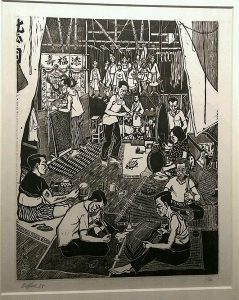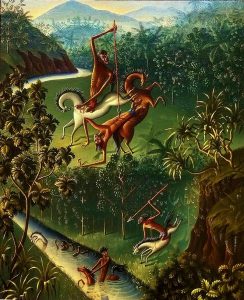
Initial Response
I was amazed by how detailed the woodcut was, with so many characters in the frame and detailed defined so clearly. I was intrigued by how the theatre performance was so different in the past as compared to today.
Analysis
What is the painting about?
This painting shows the backstage of a Chinese Puppet Theatre, with the puppet actors performing at the back and the musicians playing in front of the stage. It showcases many different Chinese instruments and how the theatres were like back in the 1960s in Singapore.
Techniques applied
The artist made use of different types of lines in wood carving to show the different textures. Especially for the floor mats, the artist used systematic lines to create the woven mat texture. The contrast between the characters and the background were also shown using black and white lines from wood carving.
Composition
Elements of this art piece were generally organised in an anti-clockwise direction. The artist also divided the picture using a one-third rule, with the puppet performers performing in the background with one-third space, and the musicians performing in the foreground with two-third space.
Artist’s Background
Lim Mu Hue was trained in Singapore’s Nanyang Academy of Fine Arts where he was greatly influenced by the Woodcut Movement from China. His woodcuts often show the socio-political themes that represent the daily life of Chinese men. He often incorporates Singapore’s lifestyle and Chinese cultures in his works. Similarly, in this woodcut, he portrayed the culture of Chinese music and theatre performance that were rather common in Singapore back then.

Initial Response
I found this painting oddly satisfying due to the structure and colours of it. It gives me a very warm vibe that attracted me to it.
Analysis
What is the painting about?
This painting depicts 3 distinct pagoda roofs, with various designs and textures for each of them. It shows the architecture used in the historical Hindu-Buddhist culture of Southeast Asia in a more abstract way.
Techniques applied
Different colours and lines were used to portray different the different textures of the pagoda roof. By using warm and cool colours to show contrast, the artist managed to make viewers look more closely at the different textures. Through simple lines and shapes and dots, he managed to bring out the different designs and textures of the pagoda roofs in an abstract manner. All these were done using oil on canvas.
Composition
The painting was divided using the one-third rule, with the first pagoda on the left occupying one-third of the space. Negative space was also used to show the sky, and upon looking closely to the sky, the negative space actually has texture to it, showing the clouds I presume.
Artist’s Background
The Malaysian painter, Latiff Mohidin, grew up in the countryside and thus his works were usually inspired by the nature and culture of Southeast Asia. Similarly, in this painting of the pagodas, he depicted the Hindu-Buddhism culture of Southeast Asia, and also the architecture design that was distinctly Southeast Asian.

Initial Response
I was attracted by this painting due to the unique painting of humans and animals in a fight. What the artist drew was not something of the norm. This painting gave me a very mysterious vibe, attracting me to want to know more.
Analysis
What is the painting about?
This painting depicts a fight ongoing between 2 groups of people. Those on the white horses were hunting those on the brown horses in the forest with spears. The exact folk legend is not known, but the distinctive characters and the Balinese landscape clearly shows the scene of a Balinese legend.
Techniques applied
Analogous shades of green and brown were used for the forest setting. With the different shades of colours, a 3D painting of the forest can be portrayed clearly. The painting even shows the detailed highlights of the leaves where light shines on them. This can be shown by the lake in the painting as well. For the characters, the artist did not use the normal way of portraying humans. Instead, he made use abstract shapes to create his own form of humans and animals. Together with the colours, he brought the characters into life.
Composition
The painting was divided into half, with the main focus on the background instead. This can be shown by the artist portraying the background characters in a larger scale as compared to the foreground characters.
Artist’s Background
The Russian painter, Walter Spies, spent most of his life in Bali, where he travelled to many villages in Bali to learn more about Balinese culture. It was during that period of time when he learnt about the legend and painted it according to how he imagined them to be. As he lived in Bali for some time, he usually infuses the Western technique and Balinese technique of art together in this painting. In this painting, he observed how Balinese puppets portray humans and used those gestures and figures in this painting to portray the characters to suit the Balinese culture.
